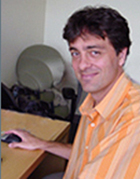
Professor, Bioengineering
Adjunct Professor, Oral Health Sciences
Office: William Foege Building, Rm. N430-N
Box: 355061
Interests
We design and use microfluidic devices to better mimic the real microenvironment of nerve and cancer cells when we culture them outside of the organism. We are microfluidic! Examples of questions that interest us are how neurons find their targets during development (axon guidance), how they establish their connections (synaptogenesis), and how we sense odors (olfaction), among other projects. We also build microfluidic devices that allow us to personalize chemotherapy and devices to study cancer stem cells.
Publications
- K.W. Moyes, C.G. Sip, W. Obenza, E. Yang, C. Horst, R.E. Welikson, S.D. Hauschka, A. Folch, and M. Laflamme, “Human embryonic stem cell-derived cardiomyocytes migrate in response to gradients of fibronectin and Wnt5a”, Stem Cells and Development 22, 1 (2013). Human embryonic stem cell-derived cardiomyocytes show robust promigratory responses to microfluidic gradients of fibronectin and Wnt5a.
- Adina Scott, Anthony K. Au, Elise Vinckenbosch, and Albert Folch, “A microfluidic D-subminiature connector”, Lab on a Chip 13, 2036 (2013). We present a novel microfluidic connector based on standard electronic components that are available worldwide.
- Peder Skafte-Pedersen, Christopher G. Sip, Albert Folch, and Martin Dufva, “Modular microfluidic systems using reversibly attached PDMS fluid control modules”, Journal of Micromech. Microeng. 23, 055011 (2013). We demonstrate the integration of PDMS-based fluid control modules with hard polymer chips made of PMMA.
- Scott, A., Weir, K., Easton, C., Huynh, W., Moody, W.J., and Folch, A., “A microfluidic microelectrode array for simultaneous electrophysiology, chemical stimulation, and imaging of brain slices”, Lab Chip 13, 527 (2013). We demonstrate electrophysiological recordings from the surface of brain slices using a PDMS device featuring multiple apertures that function as extracellular electrodes as well as chemical stimulation points.
- A. K. Au, H. Lai, B. R. Utela, and A. Folch, “Microvalves and Micropumps for BioMEMS”, Micromachines 2, 179 (2011). An in-depth review of the designs of micropumps and microvalves that have been used in the BioMEMS literature.
- C. G. Sip, N. Bhattacharjee, and A. Folch, “A Modular Cell Culture Device for Generating Arrays of Gradients Using Stacked Microfluidic Flows”, Biomicrofluidics 5, 022210 (2011). This device reports a microfluidic gradient generator for cell culture applications based on the use of stacked laminar flows.
- Hoyin Lai and Albert Folch, “Design and characterization of “single-stroke” peristaltic PDMS micropumps”, Lab Chip 11, 336 (2011). We demonstrate a new design of PDMS peristaltic pumps operated with a single control line.
- Anna Boardman, Tim Chang, Albert Folch, and Norman J. Dovichi, “Indium-Tin Oxide Coated Microfabricated Device for the Injection of a Single Cell into a Fused Silica Capillary for Chemical Cytometry”, Analytical Chemistry 82, 9959 (2010). We describe a microfabricated device for the capture and injection of a single mammalian cell into a fused silica capillary for subsequent analysis by chemical cytometry.
- Nirveek Bhattacharjee, Nianzhen Li, Thomas M. Keenan, and Albert Folch, “A neuron-benign microfluidic gradient generator for studying the response of mammalian neurons towards axon guidance factors”, Integrative Biology 2, 669 (2010). We record axonal growth of mouse embryonic cortical neurons in response to netrin gradients generated with a low-shear, open-bath microfluidic device.
- David M. Cate, Christopher Sip, and Albert Folch, “A microfluidic platform for generation of sharp gradients in open-access culture”, Biomicrofluidics 4, 044105 (2010). We demonstrate a membrane-based gradient generator that is compatible with open cell cultures.
- John M. Hoffman, Mitsuhiro Ebara, James J. Lai, Allan S. Hoffman, Albert Folch, and Patrick Stayton, “A helical flow, circular microreactor for separating and enriching “smart: polymer-antibody capture reagents”, Lab Chip 10, 3130 (2010). We report a mechanistic study of how flow and recirculation in a microreactor can be used to optimize the capture and release of stimuli-responsive polymer–protein reagents on stimuli-responsive polymer-grafted channel surfaces.
- Ellen Tenstad, Anna Tourovskaia, Albert Folch, Ola Myklebost, and Edith Rian, “Extensive adipogenic and osteogenic differentiation of patterned human mesenchymal stem cells in a microfluidic device”, Lab Chip 10, 1401 (2010).–> Inside cover article. Adipogenic and osteogenic differentiation of patterned human mesenchymal stem cells is demonstrated using long-term microfluidic perfusion.
- Figueroa, X.A., Cooksey, G.A., Votaw, S.V., Horowitz, L.F., and Folch, A., “Large-scale investigation of the olfactory receptor space using a microfluidic microwell array”, Lab Chip 10, 1120 (2010). –> Cover article & Cited in Chemical Technology Highlights section. We show simultaneous calcium recordings of mouse dissociated olfactory sensory neurons in large microarrays so that the whole repertoire of mouse olfactory receptors is probed in one experiment.
- Keenan, T.M., Frevert, C.W., Wu, A., Wong, V., and Folch, A., “A New Method for Studying Gradient-Induced Neutrophil Desensitization Based on an Open Microfluidic Chamber”, Lab Chip 10, 116 (2010). This paper demonstrates neutrophil chemotaxis measurements in an open microfluidic chamber.
- Sidorova, J.M. Li, N., Schwartz, D.C., Folch, A., and Monnat Jr., R.J. “Microfluidic-assisted analysis of replicating DNA molecules”, Nature Protocols 4, 849 (2009). This paper presents detailed protocols on how to stretch DNA on glass surfaces using microfluidic channels.